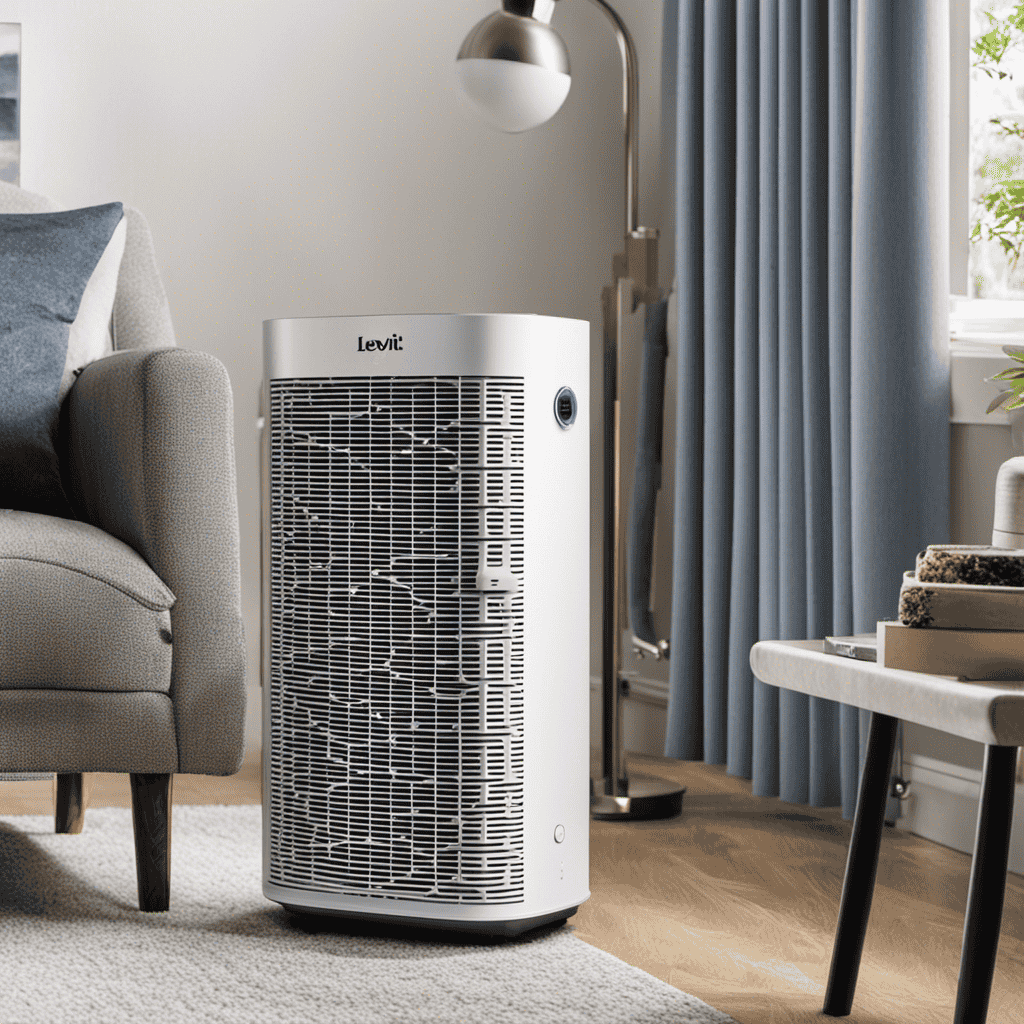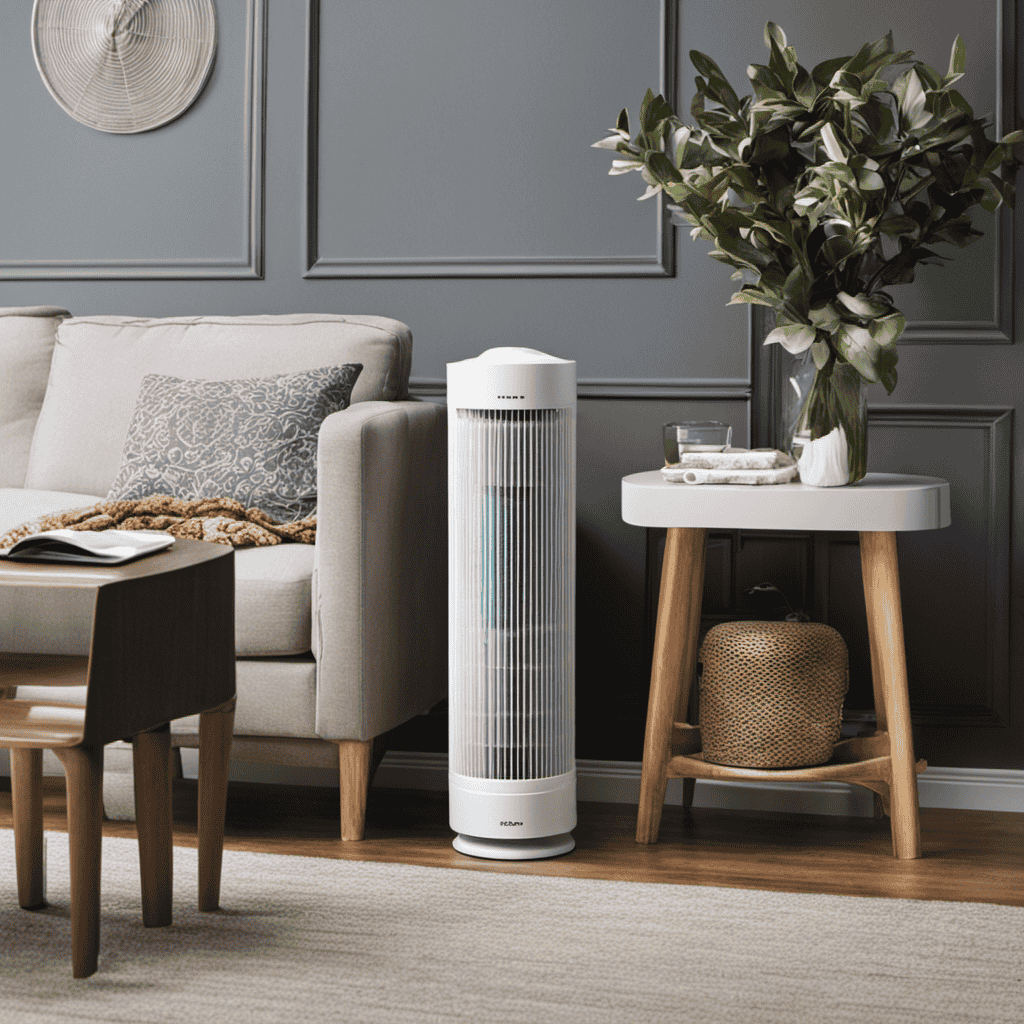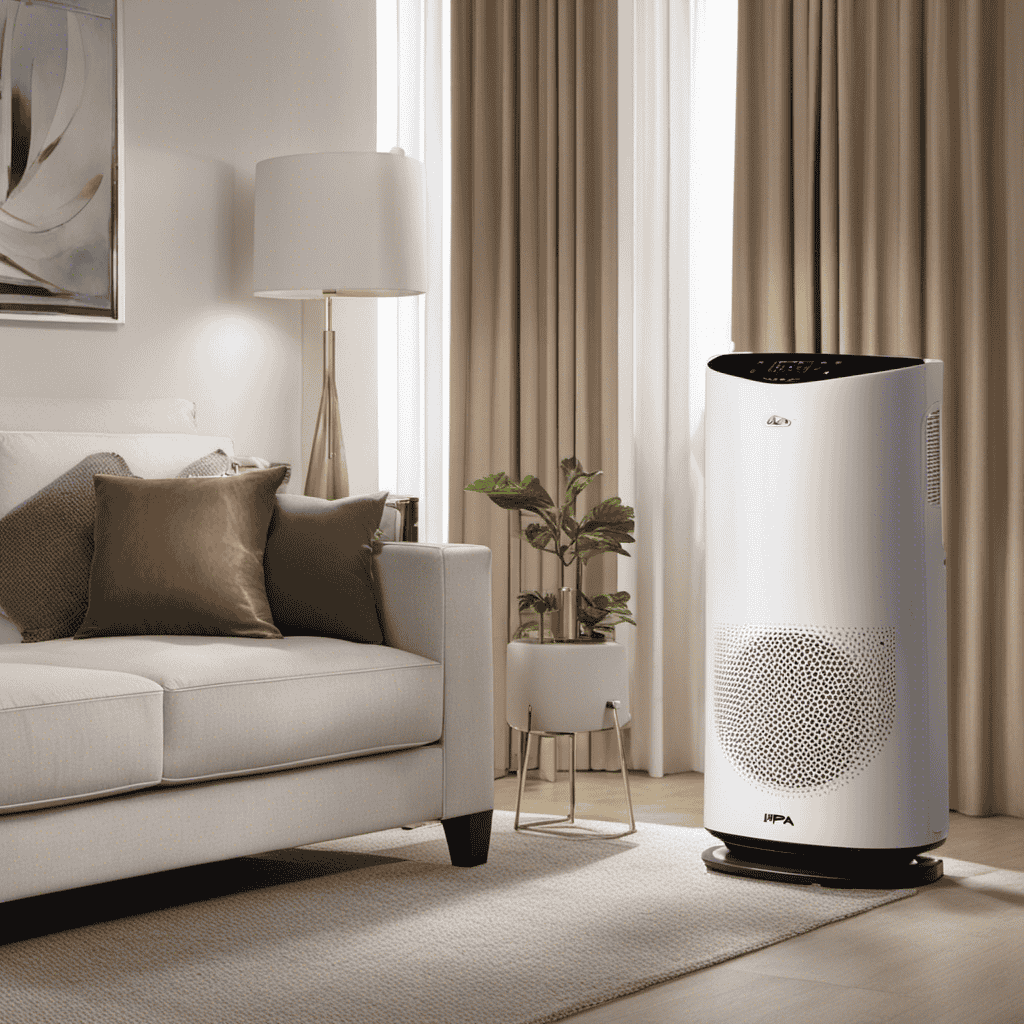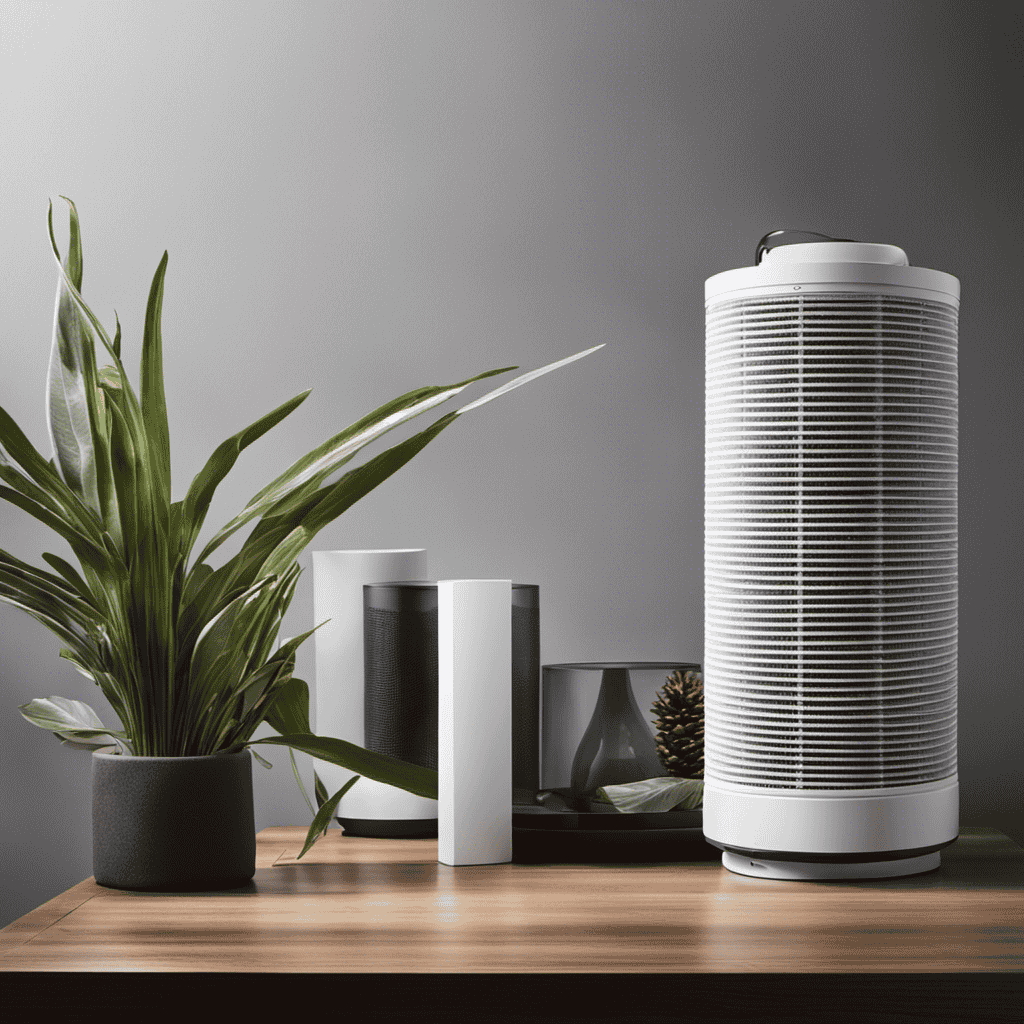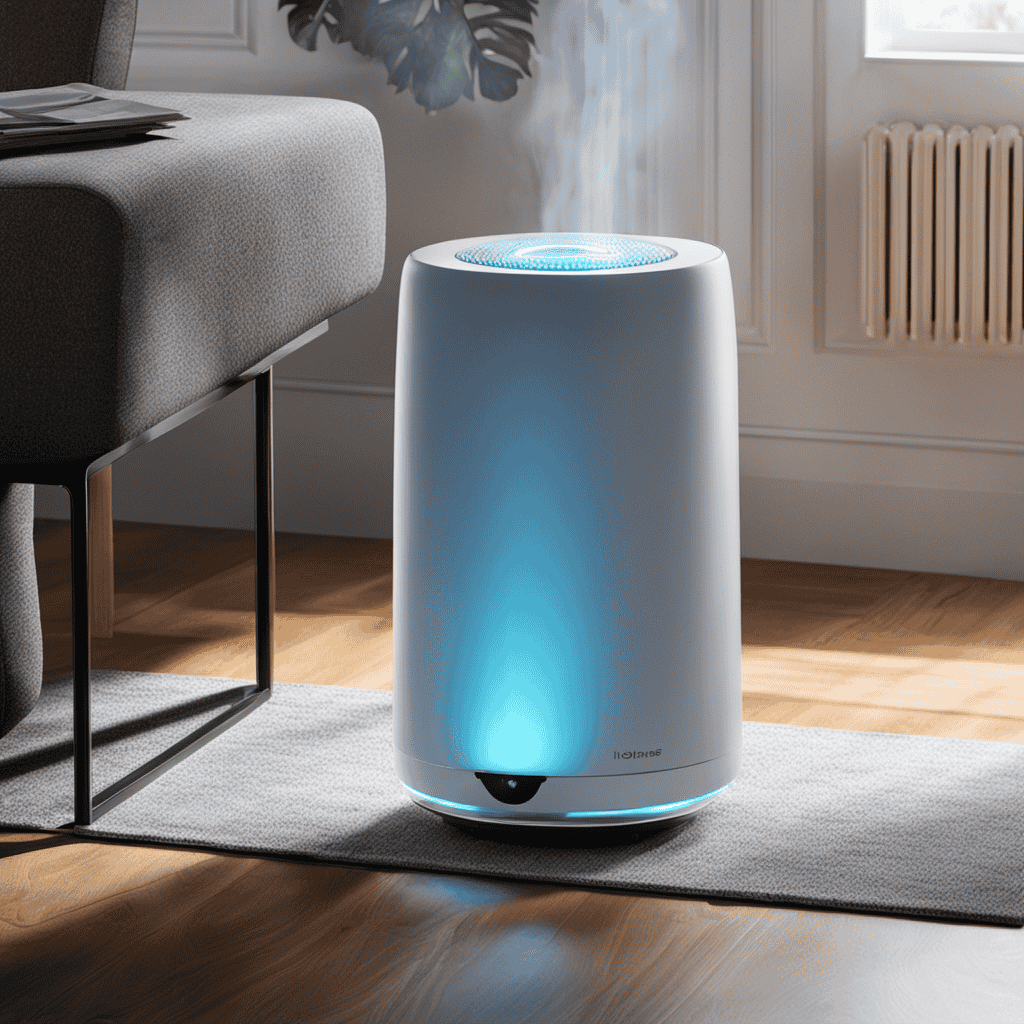As a proud owner of a Levoit air purifier, I understand the significance of maintaining clean and fresh indoor air.
But how often should I replace the air purifier filter?
In this article, I will explore the factors that affect the lifespan of the Levoit air purifier filter and provide you with guidelines on when and how to replace it.
By understanding the impact of air quality on filter longevity and the benefits of regular replacement, you can ensure that your air purifier functions at its best.
Key Takeaways
- The recommended filter replacement frequency for Levoit Air Purifier is every 6-8 months.
- Factors like air quality, pollution levels, and presence of pets or smokers may require more frequent filter replacement.
- Regular filter replacement improves air quality, reduces respiratory issues and allergies, and maintains maximum airflow and filtration.
- Cleaning the exterior of the air purifier regularly and avoiding harsh cleaning agents helps extend the lifespan of the filter.
Factors Affecting Filter Lifespan
You should consider factors like air quality and usage habits to determine how often you need to replace your Levoit air purifier filter. Proper air purifier maintenance is crucial for maintaining filter efficiency.
The lifespan of the filter depends on various factors, such as the level of pollutants in the air and how frequently the purifier is used. In areas with high pollution or allergens, the filter may need to be replaced more often. Similarly, if the purifier is used continuously or in rooms with high traffic, the filter may accumulate more particles and require more frequent replacement.
Regularly monitoring the filter’s performance and checking the manufacturer’s recommendations can help ensure that your Levoit air purifier is functioning optimally and providing clean, purified air.
Understanding Filter Lifespan
To understand the lifespan of your Levoit air purifier filter, it’s important to be aware of how long it typically lasts. Levoit air purifier filters are designed to provide efficient and effective air purification for a certain duration. Here are some key points to consider:
-
Filter maintenance:
-
Regularly clean the pre-filter to remove larger particles and extend the lifespan of the main filter.
-
Replace the filter according to the manufacturer’s recommendations to ensure optimal performance.
-
Filter performance:
-
The lifespan of the filter depends on various factors, such as the air quality in your environment and the usage time.
-
Filters may last anywhere from 6 to 12 months, but it’s essential to monitor the filter’s condition and replace it when necessary.
Proper filter maintenance and regular replacement are crucial for maintaining the filter’s performance and ensuring clean and healthy indoor air quality.
Filter Replacement Guidelines
When it’s time for a new one, make sure to follow the manufacturer’s recommendations for optimal performance.
Understanding filter efficiency and the impact of filter condition on air quality is crucial in maintaining a clean and healthy environment.
Filters are designed to capture and remove various pollutants from the air, such as dust, allergens, and pet dander.
Over time, these filters become saturated with particles, reducing their efficiency and effectiveness. A clogged or dirty filter can restrict airflow and lead to poor air quality.
Regularly replacing the filter is essential to ensure that your Levoit air purifier continues to function at its best.
The manufacturer’s guidelines will provide specific instructions on when and how to replace the filter, taking into account factors such as usage and pollutant levels in your environment.
Manufacturer’s Recommendations
When it comes to the maintenance of air purifiers, understanding the filter replacement frequency is crucial.
In this discussion, we will explore the factors affecting the lifespan of air purifier filters and the cost associated with their replacement.
By diving into these key points, we can gain a comprehensive understanding of how frequently filters should be replaced and the factors that contribute to their lifespan.
This information will ultimately help us make informed decisions regarding our air purifier maintenance.
Filter Replacement Frequency
You should replace the filter of your Levoit air purifier regularly to maintain its effectiveness. Understanding filter efficiency is crucial in combating the impact of air pollution. Here are a few key points to consider:
-
Filter lifespan: Levoit recommends replacing the filter every 6 to 8 months, depending on usage and air quality.
-
Air pollution levels: If you live in a highly polluted area or have pets or smokers at home, you may need to replace the filter more frequently.
-
Filter type: Different Levoit air purifiers use different filters, such as True HEPA or activated carbon filters. Each filter type has its own lifespan and efficiency.
-
Filter indicator: Some Levoit air purifiers come with a filter replacement indicator, which tells you when it’s time to change the filter based on usage and air quality data.
Regularly replacing your Levoit air purifier filter ensures optimal performance and cleaner air in your home.
Factors Affecting Lifespan
To extend the lifespan of your Levoit air purifier filter, it’s important to consider factors like air quality and usage.
Understanding filter efficiency and the impact of air pollutants is crucial in maintaining the longevity of your filter. Filter efficiency refers to the ability of the filter to capture and remove airborne particles effectively. Higher filter efficiency means better air purification. Factors like the size and type of particles, as well as the airflow rate, can affect filter efficiency.
Air pollutants, such as dust, pollen, pet dander, and smoke, can significantly reduce the lifespan of the filter. These pollutants clog the filter, reducing its effectiveness over time.
Regularly monitoring air quality and replacing the filter when necessary is essential for optimal performance and clean air in your indoor environment.
Cost of Replacement Filters
The cost of replacing filters for your Levoit air purifier can vary depending on the brand and type of filter you choose. It is important to consider the lifespan of the air purifier and the frequency of filter replacement when calculating the overall cost.
Here are some factors to consider:
-
Brand: Different brands offer filters at various price points. It is essential to research and compare prices to find the most cost-effective option.
-
Type of Filter: Levoit air purifiers use different types of filters, such as True HEPA or activated carbon filters. Each type has a different lifespan and cost, so it is crucial to choose the one that suits your needs and budget.
How Air Quality Impacts Filter Lifespan
Air quality plays a crucial role in the lifespan of air purifier filters. The presence of pollutants in the air can significantly impact the efficiency and longevity of these filters.
Harmful particles such as dust, pollen, and smoke can clog the filters, reducing their ability to effectively clean the air and leading to a shorter lifespan.
Therefore, understanding the impact of pollutants on air quality and filter lifespan is essential for maintaining clean and healthy indoor environments.
Air Quality and Lifespan
You should regularly monitor the air quality in your home to determine when it’s time to replace the Levoit air purifier filter. Understanding filter efficiency is crucial in maintaining clean and healthy indoor air. Here are a few key points to consider:
-
Filter Efficiency: Different types of filters have varying levels of efficiency in trapping pollutants. HEPA (High-Efficiency Particulate Air) filters are highly effective, capturing up to 99.97% of particles as small as 0.3 microns.
-
Impact of Indoor Pollutants: Indoor pollutants such as dust, pet dander, pollen, and volatile organic compounds (VOCs) can accumulate in your home. These pollutants can exacerbate allergies, asthma, and other respiratory issues.
Regularly monitoring the air quality will help you understand the filter’s lifespan and when it needs replacing. By doing so, you can ensure that your Levoit air purifier continues to effectively remove indoor pollutants, promoting a healthier living environment for you and your family.
Impact of Pollutants
Regularly monitoring indoor air quality helps in understanding the impact of pollutants and maintaining a healthier living environment. Air pollution is a significant concern as it can have detrimental effects on our health. Exposure to pollutants such as particulate matter, volatile organic compounds (VOCs), and allergens can lead to various health problems, including respiratory issues, allergies, and even cardiovascular diseases.
Understanding the sources and levels of air pollution in our indoor spaces is crucial for taking appropriate measures to mitigate its effects. By monitoring and analyzing the quality of indoor air, we can identify potential sources of pollution and implement strategies to reduce their impact. This proactive approach not only helps in safeguarding our health but also creates a cleaner and safer living environment.
Transitioning to the next section, signs of a dirty or clogged filter should not be ignored as they can compromise the effectiveness of an air purifier in removing pollutants from the air.
Signs of a Dirty or Clogged Filter
When it’s time to replace your Levoit air purifier filter, you may notice signs of a dirty or clogged filter. Regularly checking the filter condition is crucial to ensure the effectiveness of your air purifier.
Here are some signs that indicate your filter needs replacement:
-
Decreased airflow: If you notice a decrease in the airflow of your air purifier, it could be a sign that the filter is clogged with pollutants.
-
Increased noise: A dirty or clogged filter can cause the air purifier to work harder, resulting in increased noise during operation.
To maintain optimal air quality in your home, it is recommended to replace the Levoit air purifier filter every 6-8 months. However, this can vary depending on factors such as indoor air quality and usage. Regularly checking the filter condition will help you determine when it’s time for a replacement.
How Often to Check and Monitor Filter Condition
Checking and monitoring the condition of my air purifier’s filter is an important step in maintaining optimal air quality in my home. To ensure that my air purifier is effectively removing pollutants from the air, I need to inspect the filter regularly.
The frequency of inspection depends on several factors, such as the manufacturer’s recommendations, the level of air pollution in my area, and the usage of the air purifier. Generally, it is recommended to check the filter at least once every three to six months. However, if I live in a highly polluted area or if I use the air purifier more frequently, I may need to check the filter more often.
It is important to establish a monitoring schedule that suits my specific needs to ensure that the filter is clean and functioning optimally.
Average Lifespan of Levoit Air Purifier Filters
When it comes to maintaining air quality, understanding the filter replacement frequency and cost of replacements is crucial.
As a user of the Levoit air purifier, I have found that regularly replacing the filters is essential for optimal performance.
Filter Replacement Frequency
The recommended frequency for replacing the Levoit air purifier filter is every six to eight months. Regularly replacing the filter ensures optimal performance and maintains the efficiency of the air purifier.
Here’s why understanding filter efficiency and the benefits of clean air are crucial:
-
Understanding filter efficiency:
-
Filters trap airborne particles like dust, pollen, and pet dander, improving indoor air quality.
-
High-efficiency filters capture smaller particles and remove harmful pollutants, enhancing the effectiveness of the air purifier.
-
Benefits of clean air:
-
Clean air promotes better respiratory health, reducing the risk of allergies, asthma, and other respiratory conditions.
-
It helps create a healthier and more comfortable living environment, especially for individuals with sensitivities to airborne irritants.
Cost of Replacements
Replacing the filter every six to eight months can be costly, but it is a necessary expense to maintain the efficiency of the air purifier. Proper air purifier maintenance is crucial to ensure clean and healthy indoor air quality. The lifespan of the filter depends on various factors, including the type of air purifier, the level of air pollution, and the frequency of use. To give you a better understanding of the cost implications, here is a table showcasing the average filter lifespan and cost for different types of air purifiers:
| Air Purifier Type | Filter Lifespan | Filter Cost |
|---|---|---|
| HEPA | 6-8 months | $20-$50 |
| Activated Carbon | 3-6 months | $15-$30 |
| UV-C | 12 months | $25-$60 |
| Ionic | 3-4 weeks | $10-$20 |
| Ozone | 6 months | $30-$70 |
As you can see, filter lifespan and cost vary depending on the type of air purifier you own. It’s essential to factor in these costs when budgeting for air purifier maintenance.
Maintaining Air Quality
Maintaining clean indoor air quality is essential for a healthy living environment. As an air quality expert, I understand the importance of regular cleaning and proper ventilation. Here are a few key points to keep in mind:
-
Frequency of cleaning:
-
Dust and allergens can accumulate quickly, so it’s crucial to clean frequently.
-
Vacuuming carpets and upholstery at least once a week helps remove particles that can negatively impact air quality.
-
Importance of ventilation:
-
Proper ventilation allows fresh air to circulate and helps remove pollutants.
-
Opening windows regularly and using exhaust fans in bathrooms and kitchens can improve indoor air quality.
Frequency of Filter Replacement for Different Environments
For different environments, it’s important to consider how often you should replace the Levoit air purifier filter. Understanding filter efficiency and the impact of air pollution can help determine the frequency of replacement.
The efficiency of a filter refers to its ability to remove particles from the air. Filters with higher efficiency can capture smaller particles, resulting in cleaner air. However, as the filter becomes saturated with pollutants, its efficiency decreases.
In areas with high levels of air pollution, such as cities or near industrial areas, the filter may need to be replaced more frequently, possibly every three to six months. In cleaner environments, such as rural areas with less pollution, the filter may last longer, up to six to twelve months.
Regularly monitoring the filter and assessing the air quality can help determine the appropriate replacement schedule.
Filter Replacement for Allergy and Asthma Sufferers
Understanding the impact of air pollution on allergy and asthma sufferers can help determine the appropriate frequency of filter replacement. For individuals with allergies and asthma, air pollution, such as pollen, dust, and pet dander, can trigger symptoms and worsen their condition. Here are two factors to consider when determining the frequency of filter replacement for allergy and asthma sufferers:
-
Sensitivity to allergens: Allergy and asthma sufferers are more sensitive to airborne allergens. Their filters may become clogged faster, reducing their effectiveness in capturing pollutants. Therefore, frequent filter replacement is necessary to maintain clean air quality and minimize the risk of symptoms.
-
Air quality in the surrounding environment: The frequency of filter replacement may also depend on the air quality in the surrounding area. If the area is prone to high levels of air pollution, such as near busy roads or construction sites, more frequent filter replacement may be required to ensure optimal air quality.
Considering these factors, it is crucial for allergy and asthma sufferers to regularly replace their air purifier filters to maintain clean air quality and reduce the risk of triggering symptoms.
In the subsequent section, we will explore the importance of filter replacement for pet owners.
Filter Replacement for Pet Owners
To keep your home free from pet dander and allergens, regularly check and change the filters in your air purifier.
As a pet owner, I understand the importance of maintaining clean air in my home for both my family’s health and the well-being of our furry friends. Pet dander, hair, and other allergens can easily accumulate in the air, causing discomfort and potential respiratory issues.
To combat this, it is crucial to adhere to a proper air purifier maintenance routine. For pet owners, I recommend checking and changing the filters every three to six months, depending on the level of pet hair and dander in your home.
Regularly inspecting and replacing the filters will ensure that your air purifier continues to effectively remove pet allergens, keeping your indoor air fresh and clean. Remember, a clean filter means healthier air for both you and your pets.
Benefits of Regular Filter Replacement
Maintaining a regular filter replacement schedule ensures that I am consistently improving the air quality in my home. By regularly changing the filters in my air purifier, I can ensure optimal performance and effectiveness in removing pollutants from the air.
Here are some benefits of regular filter replacement:
-
Improved Air Quality: Regularly replacing filters helps to remove dust, pollen, pet dander, and other airborne particles, ensuring cleaner and fresher air in your home. It reduces the risk of respiratory issues and allergies caused by poor air quality.
-
Increased Filter Performance: Over time, filters become clogged with particles, reducing their efficiency. Regular replacement helps to maintain maximum airflow and filtration performance. It ensures that the air purifier operates at its peak performance, providing the best possible air purification for your home.
Cost Considerations for Filter Replacement
In my previous section, I discussed the benefits of regularly replacing the Levoit air purifier filter. Now, let’s delve into the cost considerations for filter replacement. It’s important to understand the factors that can affect the lifespan of the filter, as this directly impacts the cost involved.
To provide a comprehensive overview, I have prepared a table highlighting the key factors that influence the lifespan of the Levoit air purifier filter and the associated cost considerations:
| Factor | Impact on Filter Lifespan | Cost Consideration |
|---|---|---|
| Air Quality | Higher pollution levels decrease filter lifespan | More frequent replacements may be needed |
| Filter Type | Different filter types have varying lifespans | Some filters may be more expensive to replace |
| Usage Time | Longer usage hours can reduce filter effectiveness | Filters may need to be replaced more often |
Considering these factors will help you plan for the cost of filter replacements. However, there are also ways to extend the lifespan of your Levoit air purifier filter. Let’s explore some tips in the next section.
Tips to Extend Filter Lifespan
In this discussion, I’ll be exploring the proper maintenance techniques and strategies to prolong the effectiveness of air purifier filters.
As an avid user of air purifiers, I’ve learned that regular maintenance is crucial in ensuring optimal performance and longevity of the filters.
Proper Maintenance Techniques
Make sure you regularly clean the exterior of your Levoit air purifier to keep it functioning properly. Cleaning the exterior of your air purifier is just as important as cleaning the filter.
Here are some tips to help you maintain your Levoit air purifier:
-
Frequency of Cleaning:
-
Clean the exterior of your air purifier at least once a month.
-
If you live in a dusty or polluted area, consider cleaning it more frequently, such as every two weeks.
-
Common Mistakes:
-
Avoid using harsh cleaning agents or abrasive materials on the exterior of your air purifier, as they can damage the surface.
-
Do not submerge your air purifier in water or any other liquid.
Regularly cleaning the exterior of your Levoit air purifier will not only keep it looking nice, but it will also ensure proper functionality and prolong its lifespan.
Prolonging Filter Effectiveness
Regularly cleaning the exterior of your Levoit air purifier helps to maintain the effectiveness of the filter. Factors affecting the longevity of the filter include the level of air pollution in your area and the frequency of use.
If you live in an area with high levels of pollutants, such as near a busy road or in a city, the filter may need to be replaced more often. Additionally, if you use the air purifier constantly, the filter will accumulate more particles and may need to be replaced sooner.
To prolong the effectiveness of the filter, it is recommended to clean the exterior of the air purifier regularly by wiping it with a damp cloth. This helps to remove any dust or debris that may clog the filter and reduce its performance.
Importance of Proper Filter Maintenance
Proper filter maintenance is vital for maximizing the efficiency of your Levoit air purifier. As an owner of this advanced technology, it’s important to understand the frequency of cleaning and the benefits of clean filters. Here’s what you need to know:
-
Regular cleaning: Cleaning your air purifier’s filter should be done every three to six months, depending on usage and environmental conditions. This ensures optimal performance and prolongs the lifespan of your filter.
-
Improved air quality: Clean filters effectively capture and remove airborne particles such as dust, pollen, pet dander, and mold spores. By maintaining clean filters, you’ll experience cleaner, fresher air in your home, reducing the risk of allergies and respiratory issues.
-
Energy efficiency: When your filters are clean, your Levoit air purifier doesn’t have to work as hard to circulate air. This results in lower energy consumption, saving you money on your electricity bills.
Frequently Asked Questions
Can I Wash and Reuse a Levoit Air Purifier Filter?
No, you cannot wash and reuse a Levoit air purifier filter. It is recommended to replace the filter every 6-8 months, depending on usage. Using a Levoit air purifier consistently provides numerous benefits for cleaner air.
Is It Necessary to Replace the Filter if I Only Use the Air Purifier Occasionally?
If I only use the air purifier occasionally, it may not be necessary to replace the filter as frequently. However, it’s important to consider cost-effective solutions and alternative maintenance methods to ensure optimal air quality.
Can I Use a Third-Party Filter Instead of a Levoit Replacement Filter?
I can use a third-party filter as an alternative to a Levoit replacement filter, but there are pros and cons to consider. While it may be cheaper, it could affect the performance and warranty of the air purifier.
How Do I Know if My Levoit Air Purifier Filter Needs to Be Replaced?
I can determine when to replace my Levoit air purifier filter by monitoring its performance and checking for signs of a dirty filter, such as reduced air flow or unpleasant odors. The typical lifespan of a Levoit filter is around 6-8 months.
Are There Any Discounts or Promotions Available for Levoit Air Purifier Filter Replacements?
I’m not sure about discounts or promotions for Levoit air purifier filter replacements. However, it’s important to replace the filter regularly to maintain optimal air quality. You can check with Levoit or third-party sellers for availability and reusable or third-party filters.
How Regular Cleaning Can Prolong the Life of Levoit Air Purifier Filter?
Regular cleaning of the Levoit air purifier filter is essential for maintaining its efficiency and extending its lifespan. By regularly cleaning the filter, you can ensure that it continues to effectively remove pollutants from the air, ultimately prolonging the life of the air purifier itself.
Conclusion
In conclusion, it can be confidently stated that regular filter replacement for the Levoit air purifier is crucial for optimal performance and air quality. Factors such as air quality, usage time, and maintenance play a significant role in determining the lifespan of the filter. By following the manufacturer’s recommendations and implementing proper maintenance, users can enjoy cleaner air and reap the benefits of a longer-lasting filter.
Additionally, considering the cost implications of filter replacement and implementing tips to extend filter lifespan can further enhance the overall experience.
